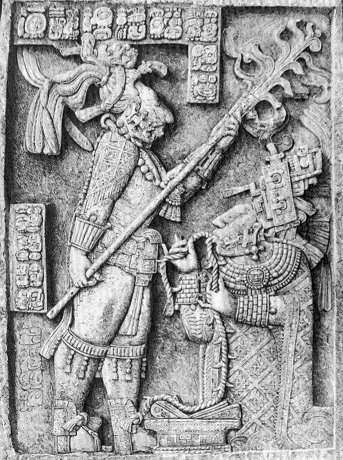Itzamnaaj Bʼalam II
Itzamnaaj Bʼalam II was a Maya king who ruled in Yaxchilan from 681 until he died in 742. He is also called Shield Jaguar II by modern writers and commonly referred to simply as Shield Jaguar based on his name glyph before the phonetic name was deciphered.
| Itzamnaaj Bʼalam II | |
|---|---|
| King of Yaxchilan | |
 | |
| Reign | 681–742 |
| Predecessor | Yaxun Bʼalam III |
| Successor | Yaxun Bʼalam IV |
| Born | 647 |
| Died | 742 |
| Consort | Lady Xoc Lady Eveningstar Lady Sak Bʼiyaan[1] |
| Issue | Yaxun Bʼalam IV |
| Father | Yaxun Bʼalam III |
| Mother | Lady Pacal |
| Religion | Maya religion |
Family
Itzamnaaj Bʼalam was born in 647 to Lady Pacal and Yaxun Bʼalam III and later had a son named Yaxun Bʼalam IV who ascended to the throne after Itzamnaaj Bʼalam's death.
His grandmother was Lady Xibalba, noblewoman of Yaxchilan.
Early life
Little is known of Itzamnaaj Bʼalam's early life except that when he was eleven years old one of his siblings participated in a war that involved Pacal, the famous king of Palenque.
Accession and reign
In order to become king, Itzamnaaj Bʼalam defeated Ah Ahaual (a Mayan noble) in war and took him captive to Yaxchilan. At the age of 34 around October 23, 681, he became king of Yaxchilan. He was married to his aunt, Lady Xoc, and she held a great amount of power.
One of Itzamnaaj Bʼalam's greatest accomplishments was the construction of what is now called Temple 23. At Temple 23, Lady Xoc is shown performing a bloodletting ritual for three occasions: Itzʼamnáj Bʼalam's accession to the throne, the birth of Yaxun Bʼalam, and the dedication of Temple 23.
Preparing for an heir
Itzamnaaj Bʼalam had a second wife named Lady Eveningstar of Calakmul with whom he had a son named Yaxun Bʼalam. He chose Yaxun Bʼalam to be his successor despite the fact that Lady Xoc, his other wife, had a strategically important bloodline.
It is believed by Linda Schele and David Freidel that Itzamnaaj Bʼalam had Temple 23 in Yaxchilan constructed to honor Lady Xoc while also gaining public support for his son to become king.
He also married Lady Sak Bʼiyaan, but she was not of so high status as his aunt.
End of the reign
The majority of the buildings constructed during Itzamnaaj Bʼalam's reign occurred in the last third of his life. He was still leading his troops to battle in his eighties.
Itzamnaaj Bʼalam died at the age of 95.
References
- The Ancient Maya by Robert J. Sharer and Loa P. Traxler
- Martin, Simon; Nikolai Grube (2008). Chronicle of the Maya Kings and Queens: Deciphering the Dynasties of the Ancient Maya (2nd, revised ed.). London and New York: Thames & Hudson. ISBN 978-0-500-28726-2. OCLC 191753193.
- Schele, Linda; David Freidel (1992). A Forest of Kings: The Untold Story of the Ancient Maya (pbk reprint ed.). New York: Harper Perennial. ISBN 0-688-11204-8. OCLC 145324300.
- Sharer, Robert J.; Loa P. Traxler (2006). The Ancient Maya (6th, fully revised ed.). Stanford, CA: Stanford University Press. ISBN 0-8047-4816-0. OCLC 28067148.
| Preceded by Yaxun Bʼalam III |
High Kings of Yaxchilan 681–742 |
Succeeded by Yaxun Bʼalam IV |